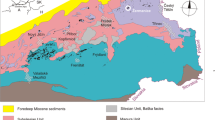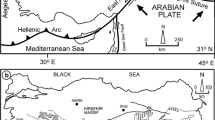Abstract
Variations in chemistry and related physical properties of sheet silicates in the Ouégoa district with metamorphic grade are investigated. Weakly metamorphosed rocks prior to the crystallization of lawsonite contain phengite (d 006=3.317–3.323 Å), chlorite and occasionally paragonite while interstratified basaltic sills contain chlorite, minor phengite and stilpnomelane. Pyrophyllite crystallizes before lawsonite in some metamorphosed acid tuffs and is also stable in the lawsonite zone. Paragonite, phengite and chlorite appear to be stable through the sequence from weakly metamorphosed rocks into high-grade “eclogitic” schists and gneisses.
Optical, chemical and some X-ray diffraction data is given for representative sheet silicates. Electron probe analyses of 55 phengites, 21 paragonites, 57 chlorites, 12 vermiculites, 2 stilpnomelanes, and 2 chloritoids are presented in graphical form.
All K-micas analysed are consistently phengitic (3.29–3.55 Siiv ions per formula unit) and show limited solid solution with paragonite (4 to 13% Pa). The K∶Na ratio of the phengite is strongly dependant on the assemblage in which it occurs; the amount of phengite component and its Fe∶Mg ratio depends on bulk-rock composition. Phengites from acid volcanics have the highest Fe∶Mg ratio, highest phengite component and β refractive indices. Phengites from basic volcanics and metasediments of the epidote zone have the lowest Fe∶Mg ratio. Phengites from lawsonite-zone metasediments have intermediate Fe∶Mg ratios. The phengites show a small decrease in phengite component with increasing metamorphic grade. d 006 for phengites varied from 3.302 to 3.323 Å but at least in the lawsonite and epidote zones appears to reflect composition and had little systematic variation with metamorphic grade; phengites from very low-grade rocks showed the longest values of d 006. Paragonite shows almost no phengite-type substitution and only limited solid solution (4–12%) with muscovite. All paragonites (6) and most phengites (20) which have been examined are 2M1 polymorphs; one Fe2+-phengite appears to be a 1M polymorph.
The chemistry of chlorites closely reflects parent-rock chemistry. Chlorites from metasediments have distinctly higher Fe/(Fe+Mg) ratios than chlorites from basic igneous rocks; chlorites from the lawsonite and lawsonite-epidote transitional zone metasediments have the highest Fe/(Fe+Mg) ratios. In metabasalts Fe/(Fe+Mg) ratios appear to reflect individual variations in bulk-rock chemistry and show no direct correlation with metamorphic grade. There is little difference in Al/(Si+Al) ratio between chlorites from sediments and basic igneous rocks although in both lithologies the chlorites from the epidote zone appear to be slightly more aluminous. Fe-rich chlorites of the lawsonite zone metasediments have been altered by a process involving leaching of Fe and Mg and introduction of alkalies to a brown pleochroic Fe-vermiculite. Chemical and physical data for this vermiculite are given.
The decrease in Fe/(Fe+Mg) ratio in chlorites and phengites on passing from the lawsonite to the epidote zone can be correlated with the crystallization of Fe-rich epidote and almandine in the epidote zone. Elemental partitioning between coexisting minerals has shown Ti to be partitioned into phengite, while Fe and Mn are strongly partitioned into chlorite. When either stilpnomelane or chloritoid coexists with phengite or chlorite, Fe and Mn are slightly enriched in the stilpnomelane or chloritoid relative to the chlorite.
Similar content being viewed by others
References
Barshad, I., Kishk, F. M.: Soil vermiculite clays. Clays and Clay Minerals, 18, 127–137 (1970)
Black, P. M.: Ferroglaucophane from New Caledonia. Am. Mineralogist 55, 508–511 (1970)
Black, P. M.: Mineralogy of New Caledonian metamorphic rocks. I. Garnets from the Ouégoa district. Contrib. Mineral. Petrol. 38, 221–235 (1973a)
Black, P. M.: Mineralogy of New Caledonian metamorphic rocks. II. Amphiboles from the Ouégoa district. Contrib. Mineral. Petrol. 39, 55–64 (1973b)
Black, P. M.: Mineralogy of New Caledonian metamorphic rocks. III. Pyroxenes, and major element partitioning between coexisting pyroxenes, amphiboles and garnets from the Ouégoa district. Contrib. Mineral. Petrol. 45, 281–288 (1974a)
Black, P. M.: Oxygen isotope study of metamorphic rocks from the Ouégoa district, New Caledonia. Contrib. Mineral. Petrol. 47, 197–206 (1974b)
Brothers, R. N.: High-pressure schists in Northern New Caledonia. Contrib. Mineral. Petrol. 46, 109–127 (1974)
Brown, E. H.: The greenschist facies in part of Eastern Otago, New Zealand. Contrib. Mineral. Petrol. 14, 259–292 (1967)
Chatterjee, N. D.: On the widespread occurrence of oxidised chlorites in the Pennine Zone of the Western Italian Alps. Contrib. Mineral. Petrol. 12, 325–339 (1966)
Coleman, R. G.: Glaucophane schists from California and New Caledonia. Tectonophysics 4, 479–498 (1967)
Curtis, C. B., Brown, P. E., Somogyi, V. A.: A naturally occurring sodium vermiculite from Unst Shetland. Clay Min. 8, 15–19 (1969)
Ernst, W. G., Seki, Y., Onuki, H., Gilbert, M. C.: Comparative study of low-grade metamorphism in the California coast ranges and the outer metamorphic belt of Japan. Geol. Soc. Am. Mem. 124, 276 p. (1970)
Foster, M. D.: Interpretation of the composition and a classification of the chlorites. U. S. Geol. Surv. Profess. Papers 414-A, 1–33 (1962)
Frey, M.: The step from diagenesis to metamorphism in pelitic rocks during Alpine orogenesis. Sedimentology 15, 261–279 (1970)
Frey, M., Niggli, E.: Margarite, an important rock-forming mineral in regionally metamorphosed low-grade rocks. Naturwissenschaften 59, 214–215 (1972)
Frey, M., Hunziker, J. C., Roggwiller, P., Sohindler, C.: Progressive niedriggradige Metamorphose glaukonitführender Horizonte in den helvetischen Alpen der Ostschweiz. Contrib. Mineral. Petrol. 39, 185–218 (1973)
Grieve, R. A. F., Fawcett, J. J.: The stability of chloritoid below 10 Kb \({\text{P}}_{{\text{H}}_{\text{2}} {\text{O}}}\). J. Petrol. 15, 113–139 (1974)
Guidotti, C. V.: A comment on ‘Chemical study of minerals from the Moine Schists of the Ardnamurchan area, Argyllshire, Scotland’, by B. C. M. Butler and its implications for the phengite problem. J. Petrol. 10, 164–170 (1969)
Hytönen, K.: A preliminary report on an iron-rich formation near Raahe in the gulf of Bothnia, Finland. Bull. Geol. Soc. Finland 40, 135–144 (1968)
Jackson, M. L.: Soil clay mineralogical analysis. In: Soil clay mineralogy, eds. C. I. Rich and G. W. Kunze. Chapel Hill: University of North Carolina Press 1964
Kishk, F. M., El-Sheemy, H. M.: Potassium selectivity of clays as affected by the state of oxidation of their crystal structure iron. Clays and Clay Minerals 22, 41–47 (1974)
Lacroix, A.: Les glaucophanites de la Nouvelle-Caledonie et les roches qui les accompagnent, leur composition et leur genèse. Mem. Acad. Sci. Paris 65, 1–103 (1941)
Ross, G. J., Kodama, H.: Experimental transformation of a chlorite into a vermiculite. Clays and Clay Minerals 22, 205–211 (1974)
Smith, J. V., Yoder, H. S.: Experimental and theoretical studies of the mica polymorphs. Mineral. Mag. 31, 209–235 (1956)
Taylor, H. P., Coleman, R. G.: O18/O16 ratios of coexisting minerals in glaucophane-bearing metamorphic rocks. Bull. Geol. Soc. Am. 79, 1727–1756 (1968)
Author information
Authors and Affiliations
Rights and permissions
About this article
Cite this article
Black, P.M. Mineralogy of New Caledonian metamorphic rocks. Contr. Mineral. and Petrol. 49, 269–284 (1975). https://doi.org/10.1007/BF00376180
Received:
Issue Date:
DOI: https://doi.org/10.1007/BF00376180




